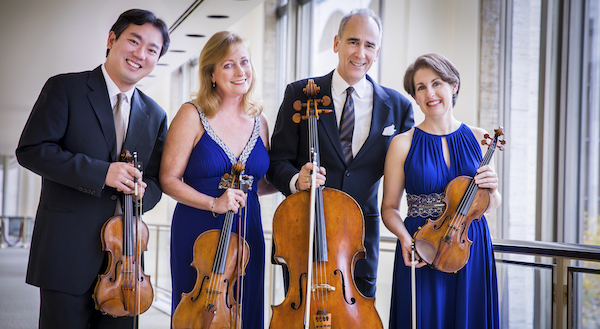New York Phil Quartet, Kalichstein compelling partners at FIU

The New York Philharmonic String Quartet performed Sunday night at FIU’s Wertheim Performing Arts Center. Photo: Chris Lee
The chamber music of Dmitri Shostakovich represents some of the Russian composer’s most intimate and personal artistic statements. In contrast to the angst-ridden pages of his fifteen string quartets and the wartime piano trio, Shostakovich’s Piano Quintet in G minor (1941) seems lighter and more reflective but only on the surface.
Pianist Joseph Kalichstein and the New York Philharmonic Quartet offered an exciting performance of this enigmatic opus Sunday night at Florida International University’s Wertheim Performing Arts Center for Friends of Chamber Music’s first concert of the new year.
Shostakovich mixed a Bachian prelude and fugue and a Scherzo that resembles a waltz going off the rails with a finale that veers between a fizzy divertimento and darker Russian pathos. The score’s final bars are almost quizzical as a big climax leads to quiet notes that seem like a connective phrase but simply end. This score is one of Shostakovich’s most intriguing works and the players offered a compelling reading that pulled all of the score’s divergent elements together.
From the first solemn chords, Kalichstein exuded pianistic authority. He brought torrents of virtuosity to the keyboard- spanning paragraphs of the Scherzo and sensitivity to the more pointed lyricism of the Intermezzo. Kalichstein was fleet and assertive in the bold Russian motif of the concluding Allegretto. He blended seamlessly with the quartet, the piano line part of the instrumental fabric rather than constantly dominant.
The NYP players met the quintet’s stylistic cross=currents on their own terms. Individual voices were strongly transparent in the fugal sections. At times the musicians thinned down their vibrato, painting Shostakovich’s personal brand of neo-Baroque rhetoric in spare textures. Violinists Frank Huang and Sheryl Staples’ duo in the fourth movement was spun in silken tones. The entire performance was splendidly coordinated with contrasts of dynamics and tempo vividly detailed.
The program’s first half featured invigorating traversals of two staples of the chamber music repertoire. Mozart’s Quartet in G Major, K.387, was crisp and fluent, the ensemble playing perfectly scaled. The slightly off-kilter curves of the Menuetto and eruptive chords of the trio were conveyed with precision. Cynthia Phelps’ burnished viola tone added depth to the corporate sonority and Huang made the quirky secondary subject of the final Molto allegro really swerve with dance-like incisiveness.
Dvořák’s familiar Quartet in F Major (“American”) was given fresh life with an exhilarating reading that dusted off the cobwebs to reveal anew the work’s wonderfully subtle fusion of American folk and vernacular influences with Slavonic dance.
The opening Allegro ma non troppo was tautly stated and refreshingly devoid of sentimentality. Cellist Carter Brey’s darkly molten sonority and nobility of phrasing took the simple thematic strands of the Lento to another level. From dulcet softness to full-blooded emotional climaxes, the players’ supple attention to dynamics paid consistent dividends. Brisk pacing of the final two movements capped a spirited and joyous ride through a unique memento of Dvořák’s 1890’s American sojourn. An unusually large audience at the Southwestern Miami-Dade campus awarded the players repeated standing ovations and bravos.
Friends of Chamber Music presents the Ehnes Quartet in an all-Beethoven program 8 p.m. January 28 at the FIU Wertheim Performing Arts Center in Miami. miamichambermusic.org
Posted in Performances
Leave a Comment
Mon Jan 6, 2020
at 12:24 pm
No Comments